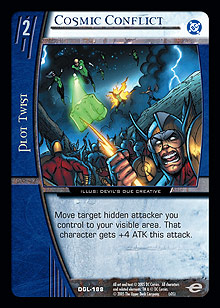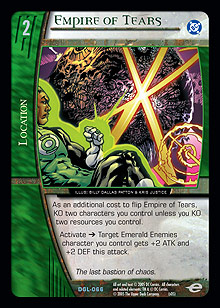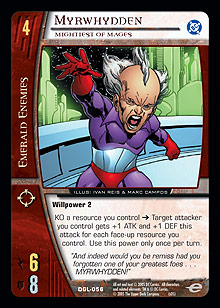
As promised, today begins a series of
Green Lantern Corps oriented Draft articles. From start to finish, this series of articles will give our slants on the common and uncommon
Green Lantern cards from the perspective of each team and deck archetype. Sprinkled liberally alongside will be discussions about basic Vs. System Draft strategies and the overall climate of the
Green Lantern set.
Pick Factors
At first glance, Vs. Draft is a simple animal. At each pass of a pack, you take the single best card and add it to your pile of cards. Forty-two cards later, you reduce to a thirty card deck and viola!, you’re done. However, the reality of drafting is that the “best” card after the first pick is extremely context sensitive. A combination of card knowledge, signal recognition, and the demands of your deck all merge in a way that makes the time limits for picking seem too short. Let’s break each of those down:
- Card Knowledge – A comprehensive knowledge of all the cards in a given pool is a critical strength in Draft. From set to set, the relative values of attack plot twists, characters of a specific cost, and other card categories change. Knowing the range of quality of a given card category (How large is the largest common attack plot twist? How many playable common 5-drop characters are there?) not only makes picking the best card easier when it shows up, it also helps you evaluate the rest of the pack and consider what cards the drafter to your left is likely to pick up.
- Signal Recognition – Signal recognition is primarily the skill of reading a pack. Near the middle of pack one, chances are good that the most powerful, flexible, generic plot twists will have already been taken, leaving a pack of team-stamped cards. For the seasoned signal reader, examining the pattern of these team-stamped cards pick after pick reveals which teams are being over- and under-drafted and allows him or her to transition safely if needed. If you’ve seen the same characters each pack, they’re either awful characters or that team is under-drafted.
- Deck Demands – This involves a basic knowledge of Vs. System deck construction combined with card knowledge. Deck demands become the focus of draft by the third pack, and sometimes as early as the beginning of the second. Simply put, drafting a fifth 5-drop when you have two plot twists is bad drafting. The best card in a vacuum must be weighed against the cards that you have already picked.
To summarize, card knowledge allows you to identify the strongest card independent of anything else, your deck demands help you reevaluate the quality of that card relative to your previous picks, and signal recognition gives you a sense of the expected overall quality of your deck. These are but a few of the important skills that Draft players develop over time.
The Climate of Green Lantern
Green Lantern Draft transitions cleanly from Marvel Knights, providing a wealth of common plot twists, team-ups, and characters. The usual tension between plot twist and character picks is similar but different; in lieu of double-loyalty characters, heavily team-stamped characters, like Kilowog and Goldface, combined with a wide range of character stats give a big incentive to draft characters early to ensure a regular curve. Team-ups allow for a reasonable fallback if your team’s characters dry up and you’ve already invested in the team. Similarly, characters like Ch’p, Dr. Ub’x, and Rocket Red serve as lynchpins for entire archetypes. All of these factors combine to make first pick/first pack characters not unreasonable in GL Draft.
 The generic plot twists in Green Lantern also fit much more effectively into certain archetypes than in previous sets. Cosmic Conflict, Shock Troops, and Qwardian Pincer, while technically generic, are vastly more or less effective depending on your character curve. At the same time, the cycle of offensive and defensive plot twists for each team ensure that there are still a reasonable number of playable mid-pick plot twists with which to fill out your deck. The fact that plot twists are overall either narrower or less powerful than in previous sets, combined with the raw power and utility of characters, suggests that an early focus on characters can result in the biggest payoff.
The generic plot twists in Green Lantern also fit much more effectively into certain archetypes than in previous sets. Cosmic Conflict, Shock Troops, and Qwardian Pincer, while technically generic, are vastly more or less effective depending on your character curve. At the same time, the cycle of offensive and defensive plot twists for each team ensure that there are still a reasonable number of playable mid-pick plot twists with which to fill out your deck. The fact that plot twists are overall either narrower or less powerful than in previous sets, combined with the raw power and utility of characters, suggests that an early focus on characters can result in the biggest payoff.
Drafting Emerald Enemies
As I alluded to in my previous article that introduced the teams in the Green Lanterns set, Emerald Enemies is half focused on willpower. However, the biggest incentives to draft the team, such as Goldface and potent uncommons like Empire of Tears, focus not on willpower but on more of a general aggro/control archetype. Other more willpower-centric effects, like Remoni-Notra ◊ Star Sapphire and Emerald Twilight, actually encourage you to splash Emerald Enemy characters rather than draft them exclusively because of their dependence on willpower. The most potent mono-EE deck to draft is a fast, aggressive deck that emphasizes low cost characters much more than usual draft decks and sacrifices high cost characters to make room for non-character cards. Not only is this archetype relatively simple to play, its lack of high cost characters allows you to fill out the meat of your character curve late into the packs. From this perspective, let’s highlight some of the more powerful Emerald Enemy and generic cards to look for.
 Empire of Tears – Quite simply, Empire of Tears is the biggest reason to draft Emerald Enemies. Seeing this card in the first three picks of a pack should put you straight into Emerald Enemies, as it means that you can expect to grab other high quality team-stamped cards like Goldface. In a set with as much flight as Green Lantern, your characters will be getting stunned on both sides of the initiative. Combine this with a low cost, off-curve strategy that the Emerald Enemies can effectively employ, and the flip cost of Empire of Tears quickly becomes insignificant. Once flipped, combat will be miserable for your opponent every single turn.
Empire of Tears – Quite simply, Empire of Tears is the biggest reason to draft Emerald Enemies. Seeing this card in the first three picks of a pack should put you straight into Emerald Enemies, as it means that you can expect to grab other high quality team-stamped cards like Goldface. In a set with as much flight as Green Lantern, your characters will be getting stunned on both sides of the initiative. Combine this with a low cost, off-curve strategy that the Emerald Enemies can effectively employ, and the flip cost of Empire of Tears quickly becomes insignificant. Once flipped, combat will be miserable for your opponent every single turn.
Chopping Block – The hardest question regarding this card isn’t whether or not to draft it; it’s whether to keep it in hand or play it. If your 4-drop is Goldface and you’re playing off-curve, you will not be able to afford the discard cost on the pertinent turns, so it’s better to equip it to a character. Furthermore, on your opponent’s initiative, a low cost character equipped with the Block will encourage your opponent to make un-aggressive attacks that you can punish with concealed characters like Sinestro Defiant and Damsel in Distress.
Goldface – Goldface’s discard cost lends him to an on-curve strategy more than an off-curve one. However, the pure swing in momentum that he provides, when combined with Major Force and Tattooed Man, will shut a game down very quickly if you’ve already established board control. While the double discard makes him difficult to splash, the prevalence of team-ups in the set and your affinity for low cost characters will enable you to pick up playable EE characters late in the Draft.
Femme Fatality – Everything you could ask for in a plot twist, Femme Fatality will always make it into your deck and provides an extra resource manipulation effect for additional boosts to Tattooed Man and Major Force. This kind of flexibility and quality in a plot twist is hard to find in Draft—take it when it’s offered.
Dr. Light – Although he’s a Constructed powerhouse, Dr. Light requires a significant investment in terms of deck construction to operate correctly in Booster Draft. Fortunately, Emerald Enemies already tends towards that lower cost curve. His ability mitigates an opponent’s attacks completely in terms of board position and throws additional characters into the fray for both Empire of Tears and willpower-totaling effects (like Emerald Twilight and Black Hand).
 Myrwhydden – Myrwhydden, Major Force, and Goldface form the triumvirate of common resource-KO effects for the Enemies’ mid- and late game. Their average-or-better stats create defensive stops that are otherwise rare in the set, and they compensate for any excess endurance loss you take by playing concealed characters.
Myrwhydden – Myrwhydden, Major Force, and Goldface form the triumvirate of common resource-KO effects for the Enemies’ mid- and late game. Their average-or-better stats create defensive stops that are otherwise rare in the set, and they compensate for any excess endurance loss you take by playing concealed characters.
Major Force – A staple 5-drop, Major Force is unimpressive without the resource-KO effects that the Enemies provide. However, he really shines with support cards like Goldface, Femme Fatality, and Sinestro Defiant. Particularly because of the lack of common and uncommon 5-drops, Force should carry extra weight in your Draft considerations.
Legion – Another ridiculously large body, Legion provides the necessary ender for a team whose strength lies not in plot twists but in locations and character powers. Legion’s drawback is easily circumvented by pacing plot twists on earlier turns (which you should doanyway to aggressively attack up your opponent’s curve) and by relying on Myrwhydden and Goldface.
Tattooed Man – As a character with better than average stats on the turns where most characters of that cost are in play, Tattooed Man fills a significant spot in the Enemies’ strategy. As he is likely to survive until turn 4 or 5, he gives you a free spin on exhaust costs for Damsel in Distress and Battered and Broken and can contribute to combat, provided enough resource KO effects.
Golden Death – Femme Fatality’s smaller, less attractive brother. The team-stamped part of this card will sometimes be worth an additional breakthrough against a four-character box formation or in combination with attack step exhaust effects like Dr. Polaris. That said, the card should be valued primarily as a +2 ATK mod, which means that it’s unimpressive but necessary.
Conclusion
Crafting an effective Enemies deck is a constant balancing act between cards that reward you for having a low number of resources and effects that enable you to KO resources. In addition to this is the tension of discard costs and playing off-curve against the number of cards in your hand at a point when you expect to draw few (if any) extra cards. This cost is largely mitigated simply by not planning to play past turn 6. The big impact of your 4- and 5-cost characters makes it reasonable to stop your curve at cost 6 or even 5 if you have a large enough variety of characters. It is critical for this archetype to hit its early drops to put significant pressure on an opponent so that turns 4 through 6 put the game out of reach.